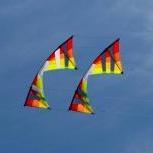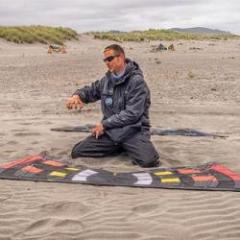I had a bit more success in this morning's practice toward a reverse 360. I had perhaps 4 successful reverse turns instead of just one.
Each one used more pressure in the sail (back up more quickly) plus a bit of forward drive on the bottom wingtip, although it's probably closer to less backward than a little forward drive. With the increased pressure in the sail it felt more prone to overcorrect/flip just like inverted flying is on outdoors when first learning the skill, but putting pressure on the kite and forcing the motion into the sail seems to be better than relying on momentum.
It doesn't have the smooth floating reverse I've seen others do, but I suspect that comes with practice and finesse.
I didn't realize downward 180 turns indoor were quite that strongly held, especially since outdoor quads seem to prefer downward 180s in group flies instead of upward 180s. I've seen some people do downard 180s in demo flys, but it is uncommon indoor. I'll remember to avoid it in the future. :-)
At the risk of derailing my own discussion a bit, my current practice topics are:
Outdoor dual: improved stalls to enable more and better precision work.
Yet another big thank-you to Paul De Bakker for ~90 minutes of stall tutoring at SPI. The old Dodd videos kept stressing they were the key, but Paul's explanations helped. My new goal is to get it to stop dead, like a quad's rock solid hover, and practice holding it for two seconds to ensure it is a solid stop rather than just a brief pause. More footwork and better timing seems to be the key. (More foot-travel and better timing of footwork seem to be present across the board.)
Outdoor quad: improved control in variable conditions through footwork instead of arm work, and axel all the time.
The megaflys showed me I need to work on stability when not flying alone; when alone the formation is done when I feel like it, when with a group the formation isn't done until the leader calls it. During one megafly I couldn't rise as quickly as others even though my neighbors were fine, during another I dropped control while we were holding position in a ball for an extended time. I think both require hoofing it, since baking up quickly with my neighbors rather than quick pulls was the part that felt different to me.
Brett Marchel helped unlock the piece of a quad axel I was missing. Before I could achieve more of a jerked snap-spin, it stayed upright and rarely laid flat. After 2 days practice on the field I can lay it nearly flat during the spin about 70% of the time, and get really flat around 20% of the time. I still sometimes get the timing wrong and it stays upright. Like the other skills, the key to unlocking it was more slack gained by footwork. The future work requires footwork timing to get the slack in place at the correct moment.
Indoor duals: launch-to-fade, gain competency at indoor slackline
Indoor quad: reverse 360
And on top of them all, gain more confidence in front of groups. Another thank you to Fletch for helping me over that last minute terror. The adrenaline rush part is good, the performance anxiety and overcorrections it causes are a problem.
For nearly all of them I'm at the point of improving an action I can perform. Those improve with practice and study.
But this reverse 360 indoor is unlike the others. I don't yet have the skill, but I'm working on it.


